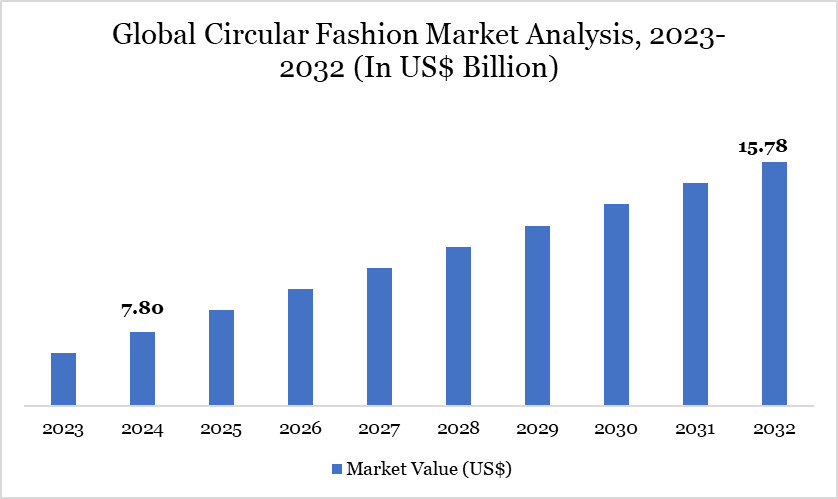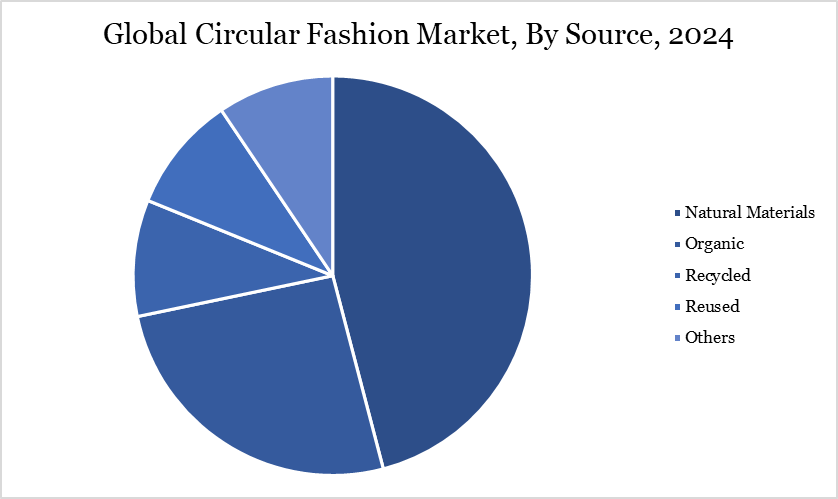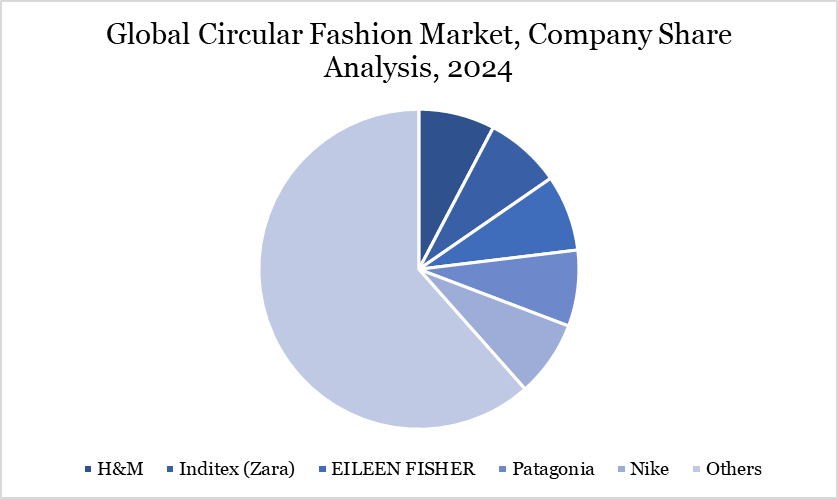Circular Fashion Market Size
Circular Fashion Market Size reached US$ 7.80 billion in 2024 and is expected to reach US$ 15.78 billion by 2032, growing with a CAGR of 9.21% during the forecast period 2025-2032.
The global circular fashion market is emerging as a critical solution to mitigate the environmental impact of the textile industry, driven by regulatory action and corporate sustainability goals. According to the European Commission, textiles are the fourth-largest cause of environmental pressure in the EU, with EU consumers discarding about 11 kilograms of textiles per person each year.
In response, governments are implementing regulatory frameworks such as the EU Strategy for Sustainable and Circular Textiles (2022), which mandates design requirements for durability and recyclability, and promotes reuse and repair. Brands are aligning with these mandates; for example, The North Face’s 2023 sustainability report notes the expansion of its “Renewed” program, which refurbishes used gear, helping divert thousands of garments from landfills.
Circular Fashion Market Trend
A key trend in the global circular fashion market is the scaling of brand-led resale and refurbishment platforms. Patagonia’s Worn Wear initiative extended the life of over 100,000 garments in 2023, as noted in its latest impact report. In France, Refashion the government-supported eco-organization collected over 250,000 tonnes of textiles in 2022 for reuse and recycling. EILEEN FISHER’s take-back program processed over 120,000 garments in 2023 alone. These efforts reflect a shift from linear consumption to product life extension backed by public policy and corporate logistics.

For more details on this report – Request for Sample
Market Scope
| Metrics | Details |
| By Product | Apparel, Accessories, Footwear, Others |
| By Source | Natural Materials, Organic, Recycled, Reused, Others |
| By Consumers | Millennials, Generation X, Generation Z, Baby Boomers, Others |
| By Distribution Channel | Online, Offline |
| By End-User | Men, Women, Children |
| By Region | North America, South America, Europe, Asia-Pacific and Middle East and Africa |
| Report Insights Covered | Competitive Landscape Analysis, Company Profile Analysis, Market Size, Share, Growth |
Circular Fashion Market Dynamics
Blockchain and Digital Technologies
Blockchain technology is revolutionizing the tracking and management of fashion supply chains, providing transparency and traceability that align with the objectives of circular fashion. Blockchain facilitates the monitoring of a product's complete lifecycle, assisting brands and consumers in recycling, resale and repurposing efforts. A garment's Blockchain record may have information like its materials, care guidelines and methods for recycling or repurposing. This fosters circularity by incentivizing consumers to return products for recycling or resale.
Radio Frequency Identification (RFID) tags and other digital technologies have significant promise to enhance transparency and traceability inside the circular fashion system. Documenting details such as fiber composition, dye usage and manufacturing provenance on blockchain ledgers might enhance efficient reuse and recycling. Digital identification tags and QR codes facilitate the tracking of apparel life cycles and supply chains. Embracing these emerging technologies presents a significant opportunity for the market.
Circular ID collaborated with 30 leading fashion labels, including H&M and PVH Corp. By 2023, they issued 500,000 digital passports for the resale of clothing, as reported by the World Economic Forum. This nascent sharing model, wherein consumers resell or rent branded goods, has the potential to disrupt the linear take-make-waste paradigm, thereby substantially enhancing the sustainability of the fashion industry.
Difficulty in Recycling
The insufficiency of proper recycling infrastructure and competencies constitutes a significant obstacle, particularly in developing nations. Sorting, cleaning and processing various used textile waste streams necessitates sophisticated equipment and technology, which requires substantial investment. This limits the uptake of recycling.
A 2024 assessment by the United Nations Environment Programme indicates that merely 9% of materials utilized by the fashion sector are presently recycled. The primary obstacles consist of clothing designs that hinder recycling, insufficient EU-wide sorting systems and an absence of economic incentive frameworks for the sector to transition from linear production models to reuse and recycling.
Circular Fashion Market Segment Analysis
The global circular fashion market is segmented based on product, distribution channel, soruce, consumer, end-user and region.

Natural Materials Driving Circular Fashion Market
The natural source highlights developments that integrate biodegradable polymers with natural fibers. These materials are engineered for total biodegradability, enabling discarded clothes to reintegrate into the biological cycle without causing environmental damage. This guarantees that each component of a product possesses identical molecular composition, facilitating sustainable end-of-life management. Partnerships with accredited suppliers enhance progress in recyclable materials, fostering a resilient ecosystem for circular fashion.
Furthermore, novel product designs, such as jackets engineered for disassembly, underscore the interplay between material and product-level advancements. The outfits are made with biodegradable sewing threads and dual-layer fabrics that can be disassembled for composting and recycling. It illustrates the capability to merge stable synthetic materials with the visual and tactile attributes of natural fibers. Instruments such as the circular design software enhance access to material data, enabling further fashion enterprises to embrace sustainable methodologies and establish new standards in textile innovation.
Circular Fashion Market Geographical Share
Demand for Circular Fashion in North America
The circular fashion sector in North America is gaining traction because to heightened consumer awareness regarding sustainability and the environmental consequences of fashion. Brands and merchants in the region are increasingly embracing circular ideas, prioritizing waste reduction via recycling, upcycling and the production of durable, reusable items.
The market is bolstered by innovative business models, like as rental services, resale platforms and take-back programs, which collectively enhance the lifespan of clothes. Government laws and regulations are increasingly fostering sustainable practices in the business, alongside technical breakthroughs like blockchain for improving transparency and AI for optimizing supply chains.
Prominent companies like Patagonia, ThredUp and Rent the Runway are spearheading this transformation, establishing industry benchmarks and showcasing the feasibility of circular fashion. This move tackles ecological issues while generating new economic opportunities, signifying a notable trend in the North American fashion and apparel sector.
Sustainability Analysis
The global circular fashion market is gaining momentum as brands and governments respond to growing environmental concerns tied to textile waste and fast fashion. According to the European Environment Agency (EEA), the textile sector is the fourth-highest pressure category for the use of primary raw materials and water, with clothing and footwear in the EU generating about 5.2 million tonnes of waste annually. In response, companies like H&M reported collecting over 18,800 tonnes of garments through their in-store recycling program in 2023, as detailed in their sustainability performance report.
Similarly, Levi Strauss & Co.’s 2023 ESG disclosure revealed that 75% of its products now incorporate recycled or sustainably sourced cotton, significantly reducing water use under its Water<Less® initiative. Government support is also increasing, with France introducing an extended producer responsibility (EPR) scheme requiring fashion brands to fund textile recycling and reuse—pushing the circular fashion agenda into mainstream operations.
Circular Fashion Market Major Players
The major global players in the market include H&M, Inditex (Zara), EILEEN FISHER, Patagonia, Levi Strauss & Co., The North Face, Nike, Adidas, Pact, and Everlane.

Key Developments
On October 3, 2024, the Circular Fashion Partnership (CFP) was officially launched in Jakarta at Alila SCBD, marking a significant step towards creating a more sustainable and circular textile industry in Indonesia. This new initiative aims to support stakeholders in fostering a circular textile industry in the region. The partnership is funded by H&M Foundation and private sector contributions and led by Global Fashion Agenda (GFA) in collaboration with the implementation partners Reverse Resources, Closed Loop Fashion, and Circle Economy Foundation, and Rantai Tekstil Lestari (RTL) acting as the National Lead.
Why Choose DataM?
Data-Driven Insights: Dive into detailed analyses with granular insights such as pricing, market shares and value chain evaluations, enriched by interviews with industry leaders and disruptors.
Post-Purchase Support and Expert Analyst Consultations: As a valued client, gain direct access to our expert analysts for personalized advice and strategic guidance, tailored to your specific needs and challenges.
White Papers and Case Studies: Benefit quarterly from our in-depth studies related to your purchased titles, tailored to refine your operational and marketing strategies for maximum impact.
Annual Updates on Purchased Reports: As an existing customer, enjoy the privilege of annual updates to your reports, ensuring you stay abreast of the latest market insights and technological advancements. Terms and conditions apply.
Specialized Focus on Emerging Markets: DataM differentiates itself by delivering in-depth, specialized insights specifically for emerging markets, rather than offering generalized geographic overviews. This approach equips our clients with a nuanced understanding and actionable intelligence that are essential for navigating and succeeding in high-growth regions.
Value of DataM Reports: Our reports offer specialized insights tailored to the latest trends and specific business inquiries. This personalized approach provides a deeper, strategic perspective, ensuring you receive the precise information necessary to make informed decisions. These insights complement and go beyond what is typically available in generic databases.
Target Audience 2024
Manufacturers/ Buyers
Industry Investors/Investment Bankers
Research Professionals
Emerging Companies